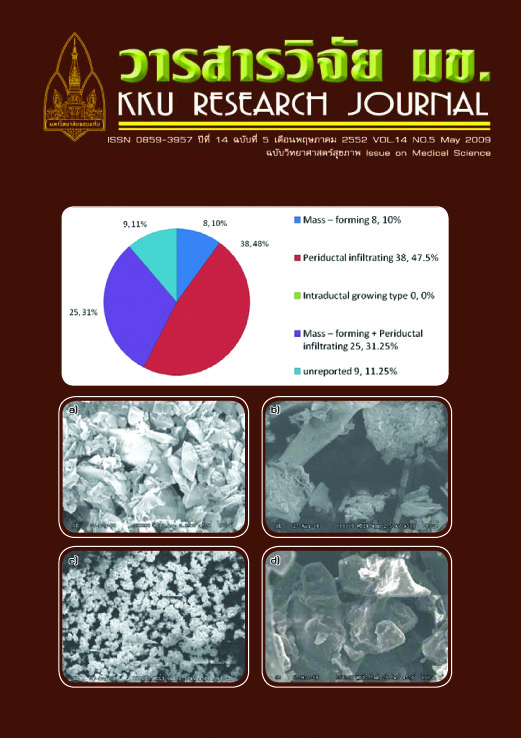The relationship of serum resistin concentration and body mass index in obese children (aged 13-15)
Main Article Content
Abstract
This research aims to determine the serum resistin concentration level in obese children and the relationship between serum resistin concentration and related parameters such as Body Mass Index (BMI), bicep skinfold thickness, tricep skinfold thickness and triglyceride level. The purposively selected volunteers were ninety-six students with BMI over X + 2 SD kg/m2 which were drawn from five secondary schools as a simple randomized unit from the entire 18 schools as the sample frame by lottery in Mahasarakham province. This protocol was ethical consideration approved by the ethics committee of Mahasarakham University. All subjects and their parents understood, consented and enrolled in this research. Thus selected students were interviewed for history of illness as healthy period during one week before blood collection, fasting blood sugar (FBS), triglyceride, serum resistin and other related biomedical parameters were determined, and anthropometric parameters measured included as height, weight, BMI, left mid-arm circumference, tricep and bicep skin fold thickness.
This study found that: 33 boys and 63 girls students had average weight 73 kg, Height 1.59 m, BMI 28.68 kg/m2 , Bicep 16.79 mm, Tricep 24.44 mm, TG 96.00 mg/dL, Resistin 5.76 ng/ml, FBS 87.00 mg/dL. The weight, height, BMI and FBS of boys was found to be higher than girls, but bicep, tricep skinfold thickness and TG of girls were higher than boys. Resistin was detected in girls ranging from 4.59 ng/ml to 8.34 ng/ml and in boys 3.71 ng/ml to 8.34 ng/ml. In girls resistin levels were higher (6.00 ± 0.87) than boys (5.29 ± 0.92). The relationship of serum resistin concentration was positively related to each anthropometric and biochemical parameter. The BMI, weight, height, bicep skinfold thickness, tricep skinfold thickness and triglyceride in both boys and girls are significantly different statistically (P < 0.05). The association of serum resistin with the marker BMI was strongly significant.
Resistin physiology of children needs to be understood, as resistin seem not to be the major link between obesity and insulin resistance, but it may be related to the maturation of children during pubertal development, ability of growth hormone to induce resistin mRNA expression, and the growth-promoting action of growth hormone. Resistin was found to have a relationship with BMI similarly to other data obtained in adults.


